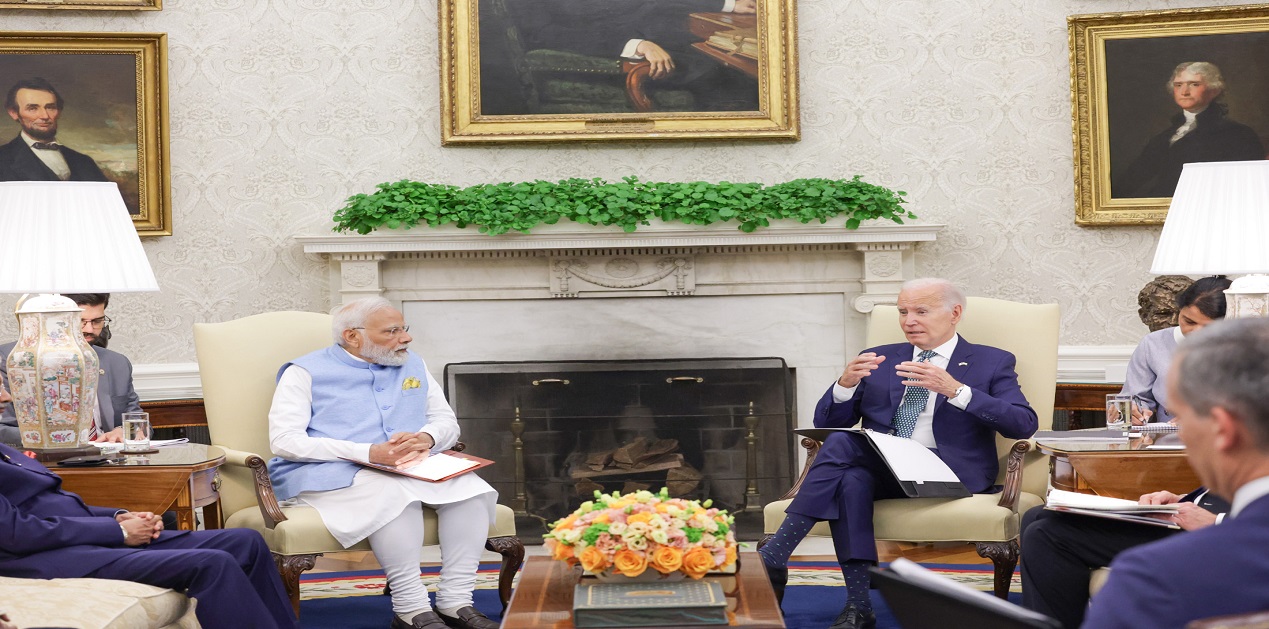In a landmark development, after initial hesitation, India has signed the Artemis Accords developed by the US, which lay down the rules and guidelines for international partners in space exploration. The Indo-US joint statement of 23rd Jun 2023 recalled the “growing cooperation between the two countries on earth and space science” and welcomed the “enhanced commercial collaboration between the US and Indian private sectors in the entire value chain of the space economy”. It promised to facilitate technology transfer and address export control issues. President Biden appreciated India’s signing of the Artemis Accords for “common vision of space exploration for the benefit of all humankind”.
Artemis Accords
In October 2020, the US, UK, UAE, Luxemburg, Japan, Italy, Canada and Australia signed the “Artemis Accords” which lay down the “principles for cooperation in the civil exploration and use of the moon, mars, comets and asteroids for peaceful purposes”. The aim of the Accords is to usher in a new era of space exploration and build upon the “legacy of the Apollo programme” and undertake “sustainable human exploration of the solar system”. The Accords underscored the global benefits of space exploration and commerce. So far twenty seven countries have signed the Artemis Accords. India is the latest to do so.
In the cold war years, the US pursued the Apollo mission programme which resulted in the first ever human landing on the moon. This established US supremacy in outer space. The American space programme also developed dual use technology and numerous military applications. As the world enters into a new phase of great power rivalries in the 21st century, the US is once again trying to maintain and further its dominance in outer space. Its Artemis programme is designed to land the first woman and next man on the surface of the moon, exploit its resources, set up human settlements there and explore Mars, asteroids and comets as well as the deep space.
A considerable body of international space law has been developed over the last five decades. In order to be acceptable internationally, the Artemis Accords specifically mention the Outer Space Treaty (1967), Rescue and Return Agreement (1968), Liability Convention (1972), and the Registration Convention (1975). The Accords emphasize peaceful nature of space cooperation (section-3), transparency (section-4), interoperability (section- 5), emergency assistance (section-6), registration of space objects (section-7), release of scientific data (section-8), preserving outer space heritage (section-9), utilisation of space resources (section -10), deconfliction of space activities (section-11), managing orbital debris (section-12) and final provisions (section-13). There are several new elements in Artemis Accords which do not find explicit mention in the earlier treaties, conventions and agreements. For instance the new activities will create new entities like ‘safety zones’ on the surface of moon. The ‘safety zone’ concept, an entirely new concept, itself is expected to change and evolve overtime. Maintaining and managing ‘safety zones’ will require new rules and definitions.
The Artemis Accords mention that “the extraction, utilisation of space resources, including any recovered from the surface or subsurface of the moon, mars, comets or asteroids should be executed in a manner that complies with the Outer Space Treaty” and that “the extraction of space resources does not inherently constitute national appropriation under Article II of the Outer Space Treaty”.
Artemis Accords do not tantamount to an international agreement. These have not been negotiated by the parties. They have been laid out by the US unilaterally in ‘take-it-or-leave-it mode’. Do they conflict with existing international conventions and space law?
The Outer Space Treaty (OST) is the mother document of space law. It envisages ‘free access’ to celestial objects for all countries and treats outer space as ‘heritage’ of mankind. However, in the new era of space exploration, the private sector is set to play an increasingly important role. The concept of private ownership of celestial resources, for instance, mining of the surface of moon for commercial purposes is envisaged.
The Significance of the Accords lies in the fact that:
- Starting with intensive exploration of moon and exploitation of its resources, the US intends to establish and reinforce its leadership role in the new era of outer space cooperation by laying down its own rules and guidelines for others.
- The Artemis Accords are unilateral. Countries which do not accept are not admitted to the US circle of partners. The rules have not been negotiated at the UN and its bodies.
- While the Artemis Accords mention the Outer Space Treaty and other space agreements and conventions, it is a matter of debate whether they comply with their provisions. The Outer Space Treaty declares that “Outer space, including the moon and other celestial bodies, shall be free for exploration and use by all States without discrimination of any kind, on the basis of equality and in accordance with international law, and there shall be free access to all areas of celestial bodies.” The Artemis Accords provide for “safety zone” to be established. This is a highly controversial idea that contradicts the principle of ‘free access’. Will safety zones be national territories is a moot question. Trump, through an executive order, had rejected the principle of no-sovereignty on celestial objects.
- In the new era of space exploration that has dawned the private sector will be a big player in space. Private sector is guided by the profit motive and private ownership. How will these be reconciled with the principles of the Outer Space Treaty that space is a ‘heritage of mankind’?
- Artemis Accords are viewed by Russia and China with a great deal of suspicion. They smell US unilateralism in them. They may come up with competing programmes. Thus, a race for the exploitation of space resources is about to begin with the US in the lead.
- The Artemis Accords have special section on interoperability of infrastructure and standards, utilisation of space resources, setting up of safety zones, mitigation of orbital debris and release of scientific data. These are highly complex technical and legal issues. The US, due to its dominance, holds asymmetric advantage and is in a position to call the shots. The devil lies in details, which have yet to be worked out.
- After defence and emerging technologies sectors, Space sector has opened up for a deeper Indo-US collaboration. This is a welcome development. However, India should be clear about its own priorities and goals, cost and benefits, and should not wittingly or unwittingly become an appendage to the US space programme. ISRO, which has historically kept its autonomy during the regime of sanctions, must retain its independence and priorities.
- There would be some scientific and technological benefits for ISRO in collaborating with NASA. These could extend the academia and industry. But, Indo-US space cooperation should result in strengthening Aatmanirbharta, transfer of technology, safeguarding of intellectual property rights, skill and talent development, fundamental and applied research etc. For instance, India needs to have advanced rockets with heavier lift capabilities to carry higher payloads. This is a crucial requirement for ISRO’s space exploration capable. Will Artemis Accords help India?
- Any partnership entails give any take. It is essential that India makes a proper assessment of costs and benefits of signing the Artemis Accords. These factors should be kept in mind while working out these details of cooperation.
Slowly and steadily space exploration is moving into new, uncharted territory. New space activities will create new facts on the ground and put more pressure on the existing space laws which are already stressed.
(The paper is the author’s individual scholastic articulation. The author certifies that the article/paper is original in content, unpublished and it has not been submitted for publication/web upload elsewhere, and that the facts and figures quoted are duly referenced, as needed, and are believed to be correct). (The paper does not necessarily represent the organisational stance... More >>
Image Source: https://www.pmindia.gov.in/wp-content/uploads/2023/06/H20230622134098.jpg










Post new comment